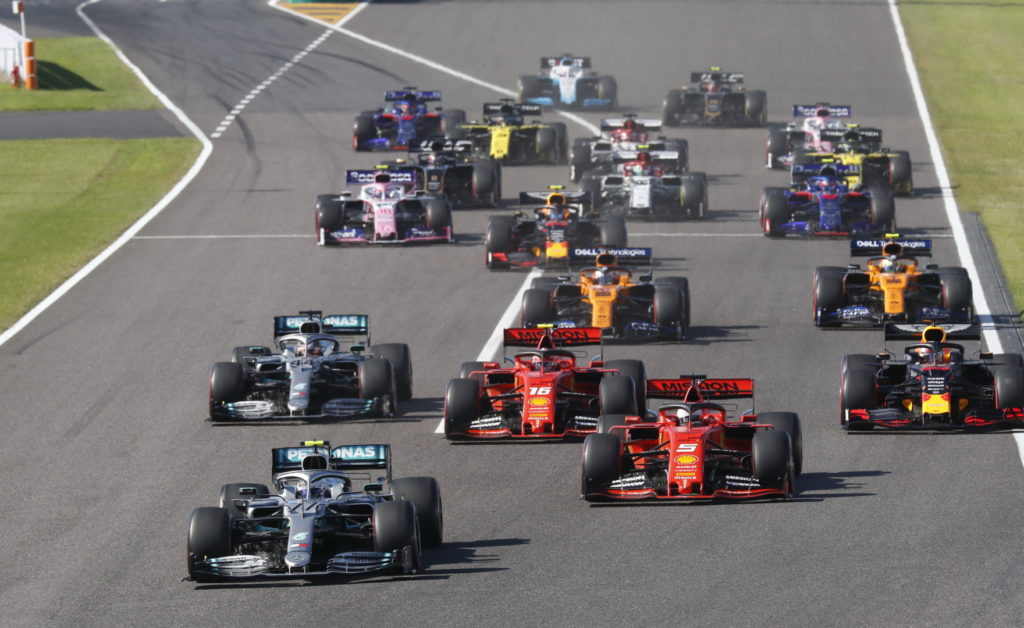The 2020 F1 season is currently due to start in July and run to December, now that F1 are starting to put an “on the fly” schedule together. Here’s our guide to the who, what and where for this year, which we’ll update as more information comes out from the teams and F1.
This season features the same 10 teams as last year, with a new name for the Toro Rosso team, now being branded as Alpha Tauri with their new sponsorship deal with the RedBull clothing label. This year there’s one rookie driver on the grid (Nicholas Latifi) and one driver returning from a year away (Esteban Ocon). In a turnaround from last year, 8 of the teams have the same lineup as we saw at the end of last season in Abu Dhabi
Mercedes-AMG Petronas Formula One Team – Car F1 W11 EQ Performance – Engine: Mercedes
- 44 Lewis Hamilton
- 77 Vatteri Bottas
Scuderia Ferrari Mission Winnow – Car SF1000 – Engine: Ferrari
- 5 Sebasitan Vettel
- 16 Charles Leclerc
Haas F1 Team – Car VF-20 – Engine: Ferrari
- 8 Romain Grosjean
- 20 Kevin Magnussen
McLaren F1 Team – Car: MCL35 – Engine: Renault
- 2 Lando Norris
- 55 Carlos Sainz
BWT Racing Point F1 Team- Car: RP20 – Engine: Mercedes
- 11 Sergio Perez
- 18 Lance Stroll
Aston Martin RedBull Racing – Car: RB16 – Engine: Honda
- 23 Alex Albon
- 33 Max Verstappen
Renault F1 Team – Car: R.S.20- Engine: Renault
- 3 Daniel Ricciardo
- 31 Eteban Ocon
Alfa Romeo Racing Orlen – Car: C39 – Engine: Ferrari
- 7 Kimi Raikkonen
- 99 Antonio Giovinazzi
Scuderia Alpha Tauri Honda – Car: AT01 – Engine: Honda
- 10 Pierre Gasly
- 26 Daniil Kvyat
ROKiT Williams Racing – Car: FW43 – Engine: Mercedes
- 63 George Russell
- 6 Nicholas Latifi (R)
Testing is even more limited during the season with the 2 days of testing after the Bahrain Grand Prix and 2 days at the Circuit de Barcelona not taking place this year due to the expanded (before postponements) calendar. Pirelli will be running private tyre tests during the season, once safe to do so and we expect the usual young drivers test to take place in early December after the last race in Abu Dhabi
Pre Season:
- Barcelona Feb 18-20
- Barcelona Feb 25 – 27
Tyre Tests:
- Cancelled for the season
Young Drivers Test
- Abu Dhabi (TBC)
We were scheduled to have a record breaking 22 races this season,but the Covid-19 pandemic has put paid to that. Currently we have the first part of the calendar released with 8 races at 6 European circuits that will all be held behind closed doors, with the possibility of more races to be added in the Americas and Asia later in the year, depending on the current status of the Covid-19 pandemic in those areas.
At the moment (8th of June) the schedule looks like this:
| Round | Race | Circuit | FP1 & FP2 | FP3 & Qualifying | Race |
| 1 | Formula 1 Rolex Grosser Preis von Osterreich | Red Bull Ring | 3 July 2020 | 4 July 2020 | 5 July 2020 |
| 2 | Formula 1 Pirelli Grosser Preis der Steiermark | Red Bull Ring | 10 July 2020 | 11 July 2020 | 12 July 2020 |
| 3 | Formula 1 Aramco Magyar Nagydij | The Hungaroring | 17 July 2020 | 18 July 2020 | 19 July 2020 |
| 4 | Formula 1 Pirelli British Grand Prix | Silverstone | 31 July 2020 | 1 August 2020 | 2 August 2020 |
| 5 | Emirates Formula 1 70th Anniversary Grand Prix | Silverstone | 7 August 2020 | 8 August 2020 | 9 August 2020 |
| 6 | Formula 1 Aramco Gran Premio de Espana | Circuit de Barcelona-Cataluny | 14 August 2020 | 15 August 2020 | 16 August 2020 |
| 7 | Formula 1 Rolex Belgian Grand Prix | Spa-Francorchamp | 28 August 2020 | 29 August 2020 | 30 August 2020 |
| 8 | Formula 1 Gran Premio Heineken d’Italia | Monza | 4 September 2020 | 5 September 2020 | 6 September 2020 |
The rules this season are pretty much unchanged from 2019 as F1 prepares for a major shakeup in 2022 ,with the only major change being that teams now get an extra MGU-K due to the extra race. One other thing of note though is that cars will now have 2 fuel flow meters installed after Ferrari may or may not have gone against the fuel flow regulations last year. Missing the weighbridge during practice sessions will now not carry an automatic disqualification from qualifying and penalties for these, along with the severity of penalties for jump starts will be down to the stewards.
Young drivers will now gain Super-Licence points for taking part in FP1 sessions, up to a maximum of 10 per season, to fast track F2 drivers into F1
Also the same compounds of tyres from 2019 will be kept on and these will also be used for the 2021 season.

